Features of orchid care
Since this plant is quite demanding on the conditions of detention, you should familiarize yourself with the basic rules for caring for it at home.
Lighting
The orchid loves light. For normal development and abundant flowering, it is necessary to create favorable conditions, namely:
- Arrange long-term daylight (at least 12 hours). If necessary, you need to extend the light period using fluorescent devices.
- Provide abundant but diffused light. Direct sunlight can be harmful.
- At the onset of the summer season, rearrange the flower in a darkened place or cover the windows with a matte film, protecting the leaves from sunburn.
- Do not darken the plant in the autumn months - soft daylight will provide a comfortable transition to a dormant state. During this period, old shoots mature and new ones are formed.
Temperature regime
Depending on the temperature required for normal growth, all types of orchids can be divided into 3 types:
- thermophilic;
- medium temperature;
- cold-loving.
The table shows the suitable conditions and temperature conditions for each type:
| Orchid type | Views | Climate | Optimum temperature |
| Heat-loving | Phalaenopsis, Cattleya, some varieties of Dendrobium | Tropical | During the day: + 18-32оC, at night: + 15-18оC, the difference per day is no more than 5 units. |
| Medium temperature | Miltonia, Odontoglossum | Mountain tropical | In summer, during the day: + 18-23 oC, at night and in winter: + 12-16 oC. |
| Cold-loving | Dendrobium, Lelia, "Lady's slipper" | Subtropical, alpine | Summer and day: up to +22 oC, in winter and at night: + 12-15 oC. |
For cultivation of varieties adapted to home conditions, the room temperature can fluctuate:
- in the afternoon - + 18-27;
- at night - + 13-24.
Air humidity
In winter, indoor air becomes dry due to the use of heating devices. You can maintain the required humidity in various ways:
- use home moisturizers;
- hang wet towels on the battery;
- put wet filler (expanded clay or moss) into the pallet of the pot with the plant;
- spray the foliage regularly (in the absence of drafts).
Watering
The watering regime is selected taking into account the specific characteristics of the plant. Some varieties grow well with sparse soil moisture, while others, on the contrary, prefer a humid environment. There are general rules that can be followed when watering an orchid:
- Use soft water for the procedure. If possible - thawed or settled rainwater. If this option is not available, you can water the plant with ordinary boiled water.
- With each session, the amount of fluid used should be moderate. Moisture stagnation is unacceptable for an orchid.
- In summer, dry soil indicates the need for watering. Usually 2-3 activities per week are enough to make the flower feel comfortable.
- During the period of active growth, when peduncles appear, during flowering, more soil moisture is required.
- At the end of flowering and in the calm phase, watering should be very moderate.
- In winter, in a cool room with low light, it is also not recommended to moisten the soil too much.
- The plant should be observed. Shriveled leaves and pseudobulbs indicate a lack of moisture. Yellowed softened leaves and rotting roots - about excess water intake.
There are 2 ways to perform the procedure:
- Place the flower pot in a container with warm water and leave for 5-10 minutes.
- Water the plant on top. Excess fluid should drain through the drain holes.
Top dressing
When caring for a flower, you should use fertilizers designed specifically for orchids:
- Bona Forte;
- Greenworld;
- Pocon et al.
It is recommended to feed the plant in accordance with the general rules, according to which:
- Fertilizers can be applied no more often than once every 3 weeks.
- The right time for feeding is the active phase, when growth accelerates and buds form.
- So that the plant does not suffer from an excess of mineral salts, fertilization of the soil should be alternated with ordinary watering.
Not recommended:
- Use fertilizers intended for other plants.
- Feed the orchid during the dormant and winter season.
- Exceed the dose indicated on the package.
According to experienced flower growers, frequent fertilization reduces the natural immunity of the plant. The flower can receive all the necessary substances from high-quality soil, which must be renewed at least once every 2 years.
Orchid transplant Cymbidium
The orchid, like any indoor flower, has to be transplanted regularly. They do this in such cases:
- when many young shoots have formed and they are clearly cramped in the pot;
- when the new shoots have grown to 7 cm and are already clearly ready to separate from the mother plant.
It is advisable to transplant the Cymbidium orchid after spring flowering, which usually ends in March and early April.
To transplant Cymbidium, you need to purchase a new container, the diameter of which will be 5-6 cm larger than the previous one. The pots should be tall and stable, similar in shape to a vase. In addition, you will need a new soil mixture.
 Before transplanting into a pot with an orchid, you need to immerse it in a large amount of water that has been previously settled for a day, leave for 50-60 minutes. Then carefully remove the plant from the pot.
Before transplanting into a pot with an orchid, you need to immerse it in a large amount of water that has been previously settled for a day, leave for 50-60 minutes. Then carefully remove the plant from the pot.
In this case, special care must be taken in relation to young shoots. They are very fragile and easily damaged.
Now you need to shave off the roots and carefully examine them.
Rotten, damaged, sick, dead, cut off with sharp scissors, rub the cut points with charcoal or activated charcoal or activated charcoal. Immerse the roots of the plant in a new pot, gently distribute the fresh substrate between them.
Council Clay pots for orchids are recommended to be bought only by experienced flower growers. Those who are not yet completely confident in their abilities are planted in transparent containers through which the condition of the roots will be visible.
Pseudobulbs should be located at the same level with the surface of the soil mixture.
It is better not to water the Cymbidium for the first day, so that small wounds on the roots, which could arise as a result of transplantation, can dry out and overgrow. After that, no additional feeding is needed for a month.
Types and varieties of culture with photos and names
There are several varieties of the Dendrobium orchid:
- Nobile or noble (Dendrobium nobile);
- Moniliforme (Dendrobium moniliforme);
- Dense-flowered (Dendrobium densiflorum);
- King (Dendrobium kingianum);
- Parish (Dendrobium parishii);
- Dendrobium phalaenopsis (Dendrobium phalaenopsis);
- Berry Oda (Dendrobium Berry Oda);
- Sa Nuk (Dendrobium Sa Nook).
We suggest that you familiarize yourself with each of them in more detail.
Nobile or noble (Dendrobium nobile)
This type of plant is usually medium in size, with a fleshy, slightly swollen stem. Its height is from 60 to 90 cm. Its leaves are oblong and are arranged in two rows.
Reference. The life span of a noble orchid is from 2 to 3 years. The inflorescences of this type of plant have a pleasant smell, their diameter is 6–8 cm. The petals take on all shades of white and pink in color. It usually blooms from January to May.
Moniliforme
Dendrobium moniliform is a small copy of the Dendrobium noble orchid. This is a very small flower, the height of which does not exceed 15 cm. It fully develops even with sudden changes in day and night temperatures. It does not suffer from direct sunlight. Blooms from late winter to early autumn, inflorescences have a light pleasant aroma.
Densiflorum
The leaves of this type of orchid are lanceolate, their size is 15 cm long and 4 cm wide.
Important! The flower stalks hang down, in the form of a vine up to 25 cm in size. The flowers are bright or pale yellow in color, very fragrant .. Flowering in this type of orchid begins in winter
Flowering in this type of orchid begins in winter.
Kinga (Kingianum)
This orchid is in most cases very miniature plants. Its stem is cylindrical, thinned upwards. Its height does not exceed 25-30 cm.
Attention! The leaves of the King's orchid are rather large, but thin, pointed upwards. In length they can reach about 10 cm, and in width 2-3 cm
The flowers are white, pink, purple and reach about 1 cm in diameter.
Parishii
Its characteristic feature is the leaves measuring about 10 cm in length and 4-5 cm in width. Peduncles are very short, but each of them has from one to four flowers. They are hot pink in color and have dark patches on the inside of the lip. The diameter of the Parisha orchid flower reaches from 4 to 7 cm. The flowering period is from February to April.
Phalaenopsis
This flower has 2 - 6 long leaves. This type of orchid resembles grapes, so its shoots also hang down.
Reference. There are a lot of flowers on Phalaenopsis, and they all differ in size and color. The diameter of the flower is from 3 to 6 cm.
The petals are large, wide in shape. Its color can be of various shades from pale pink to crimson. Some of them have a very pleasant smell.
Berry Oda
Instead of a root, this orchid has a pseudobulb. From which a thick stem grows, up to 40 cm high. There are narrow green leaves on it. In summer, peduncles with lush inflorescences appear on the bush. The flowers are small, their diameter is no more than 1 cm. They have a bright color: purple, crimson, lilac shades.
Important! The scent of the inflorescence is sweet, reminiscent of the scent of lilac. Flowering continues until autumn, and sometimes until winter.
Sa Nook
This species has a characteristic appearance for an orchid - pseudobulbs, a thick stem, long green leaves with a glossy surface. Its difference is the possibility of re-flowering. It can occur 5-7 months after the last flowering of the buds. Flowers have a fragrant sweetish scent. Their color can be:
- green;
- yellow;
- pink;
- White;
- lilac.
If you provide proper care for the Dendrobium orchid, it will delight you with its multi-colored flowers for many years. This plant is, of course, a little whimsical, but there are varieties that are even more capricious. When purchasing this type of plant, be prepared for the fact that for a certain period of time it will be dormant.
Previous
Orchids A rare species of Phalaenopsis is the Wild Cat Orchid. Description, features of care and reproduction of a flower
Next
Orchids A miracle of nature - a wild orchid. Types of a flower, its distribution, cultivation, medicinal properties
Dendrobium orchid species

Dendrobium is the most beautiful flower
Among the variety of species and varieties of orchids, it is impossible to single out any special variety that would have won universal popularity. They are all beautiful in their own way.
Dendrobium nobile (Dendrobium nobile)

Photo: Dendrobium nobile
Dendrobium nobile (Dendrobium nobile)
Vietnam and the Himalayas are considered homeland. Shiny thick pseudobulbs are characterized by rapid growth and reach 0.5 m in length already in the first year of life. In the next season, peduncles are formed, of which there are from 1 to 3 per plant. The flowers are large, rich in shades, up to 10 cm in diameter.
Natural flowers are pure white, the tips of the petals are shaded with purple, the lip is creamy, and the throat is dark purple in color. The hybrids have different colors and bloom several times a year.
Dendrobium phalaenopsis (Dendrobium phalaenopsis)

Dendrobium phalaenopsis
Dendrobium phalaenopsis (Dendrobium phalaenopsis)
The orchid got its name due to the identical shape of flowers with phalaenopsis. Naturally distributed in Australia.
Pseudobulbs, together with leathery glossy leaves, reach 0.7 m in length.The species forms simultaneously up to 10 flowers of 8 cm in diameter, which are located on a high peduncle. More often, the petals are colored burgundy.
Long bloom, up to 2 months. Falls in late November - early December. Several peduncles may appear on the same pseudobulb in one season. The best view for beginner florists.
Dendrobium moniliforme

Dendrobium moniliforme
Dendrobium moniliforme
Moniliform - noble dendrobium in miniature. The stem of the bush reaches a height of no more than 15 cm, the rosette is very beautiful. Inexperienced flower growers should have this species at home, as it is unpretentious to care for, especially since it blooms with beautiful "butterflies".
Dendrobium parishii

Dendrobium parishii
Dendrobium parishii
The pendant shoots of the epiphtic plant reach 0.3 m in length. There are also more powerful specimens.
Pointed oblong-lanceolate leaves grow up to 12 cm long. Single flowers, painted in an amethyst-purple tone, bloom on the dendrobium. The lip, rounded in shape, is densely covered with purple-brown spots, the anther is purple, the column is snow-white. It is characterized by summer flowering.
Dendrobium king (Dendrobium kingianum)
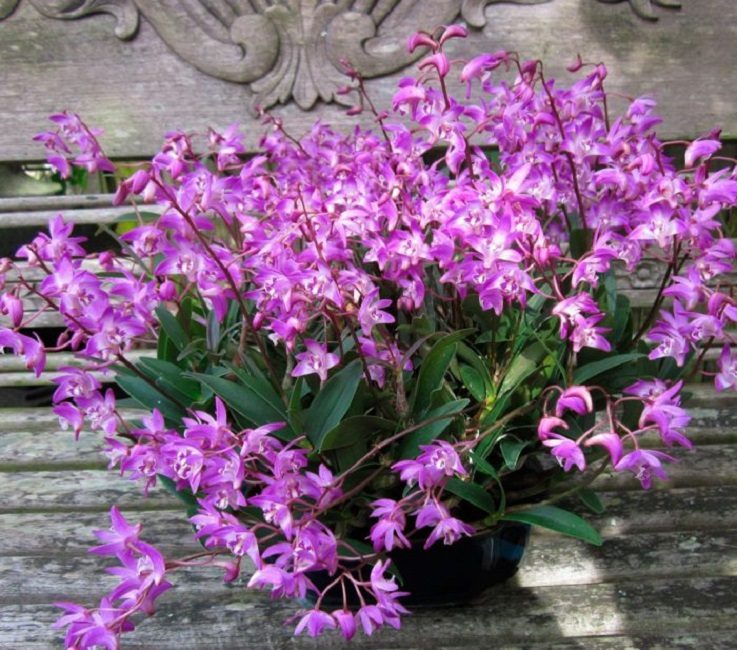
Dendrobium kingianum
Dendrobium king (Dendrobium kingianum)
Originally from Australia. The lower part of the cylindrical stems has a noticeable thickening, and wide leaves are located at the top of the stem.
The flowering is plentiful, the buds are formed in large quantities, falls on February. At this time, King's dendrobium releases a long peduncle, on which 5 pink flowers bloom, thinning the pleasant aroma.
Dendrobium densiflorum

Dendrobium densiflorum
Dendrobium densiflorum
In its natural environment, it is found in the Himalayas. Unusual coloring. All flowers have a rich orange color, which even slightly harsh the eye. The flowering is very abundant. On racemose inflorescences 0.3 m long, up to 50 flowers can bloom at the same time.
You can learn more about the representatives of the orchid family in the video below.
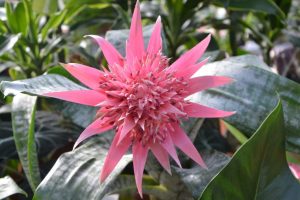
Ehmeya at home: varieties, planting and pruning, growing conditions, breeding methods, signs | (100+ Photos & Videos)
Diseases and pests
ATTENTION! Diseases arise from care errors. In case of violation of the temperature regime and with excessive watering, fungal spores quickly spread throughout the plant. Major diseases:
Major diseases:
- Root rot - the leaf darkens, the roots become soft and die off;
- Gray rot is a fluffy gray bloom on leaves, on the surface of the soil and on petals during flowering;
- Fusarium - the leaf plate becomes soft, the leaf curls and becomes covered with a pink bloom;
- Anthracnose - black spots on the leaves;
- Powdery mildew - white bloom on the leaves;
- Sooty mushroom - formed after the activity of the aphids and mealybugs. Leaves turn yellow and become covered with black bloom.

A sooty mushroom.
The appearance of pests is facilitated by the high temperature of the content and dry air. Insects feed on plant sap by sucking it out of the leaf. As a result, the process of photosynthesis is disrupted, the leaves turn yellow, the plant lags behind in growth. If untreated, the flower dies.
The main pests of Cymbidium:
- Aphid. Signs of damage - the leaves are covered with a sticky bloom;
- Shield. Signs of defeat - motionless growths on the shoots of the leaves of the peduncle;
- Spider mite. Signs of defeat - a white spider web on the leaves;
- Mealybug. Signs of damage - white "pieces of cotton wool", under which there is an insect.
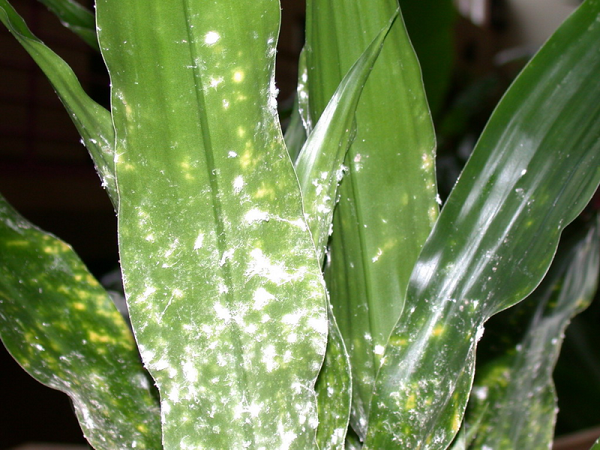
Mealybug.
Control methods
- spraying leaves to prevent the appearance of scale insects and spider mites;
- flower treatment with fungicides (Fitosporin, Topsin, Skor, Medyan Extra) and insecticides (Fitoverm, Aktofit, Aktellik) at least twice with an interval of one week;
- spraying chemicals on neighboring plants to prevent contamination;
- with root rot - drying the roots and removing damaged areas;
- processing of cuts with crushed coal to disinfect wounds;
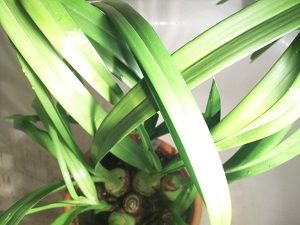
Prevention methods
- buying only healthy plants without damage;
- regular watering without stagnation of water in the roots of the plant;
- adding drainage to the flower pot;
- airing the room without strong drafts;
- reduction of watering when the room temperature drops.
Can an orchid be propagated in water?
Let's see how the conditions of half-immersed in a glass of water are optimal. Half of the stem is constantly submerged in water, which contributes to rotting even in an adult plant. The upper part in a living room will dry out from a lack of moisture.
Of course, there is a small chance - if the stars converge so that the bud is preparing to sprout on the mother plant, it may appear in spite of everything.
Hence the enthusiastic stories of flower growers about how to breed a dozen from one orchid. Another result can be obtained by placing the stalk in a bottle of water with a small portion of the twig in the water. If we provide two other conditions - light and heat, then it is quite possible to hope for the growth of shoots from the buds.
How to care for a plant after flowering
Proper care of orchids after flowering is also very important. After the flowering is completed, and the peduncle has dried up and turned black, it must be cut to the very base and removed. After flowering, plant nutrition is reduced. In winter, watering should be reduced to once a month, it is advisable to spray the plant several times with water.
If, while caring for orchids after flowering, you notice that the leaves of the flower have turned yellow and wrinkled, and it does not release a peduncle, also move the pot to another place. Then it will bloom regularly.
We hope that all the above information has come in handy for you, and you now know how to care for orchids at home and if the care is correct, this beautiful plant will regularly delight all residents of the house with flowers. After all, flowering is the most beloved period in the life of every flower lover.
Beneficial features
The beneficial properties of the orchid have been known for a very long time.
From the point of view of medicine, some varieties can be useful, for example, the "lady's slipper". A decoction made from this plant helps with neurological diseases, as well as cardiac and psychiatric disorders.
This plant is used for headaches, diseases of the nervous system, and sleep problems. The broth is good for the cardiovascular system.
Cooking applications
Orchid tubers are used in cooking. Today, pseudobulbs of this exotic flower are used for gastronomic purposes in Mexico. In 19th century France, orchid leaves were added to cream.
Vanilla, a genus of lianas of the Orchid family, has the greatest value for cooking, the fruits of which are used as a spice called "vanilla". The name comes from the Latin word vainilla, which translates as "pod". This genus of plants is common in the tropics and subtropics. More than 50% of the world's spice production comes from Madagascar. It is obtained as a result of special processing of the fruit. To begin with, the collected pods are dipped in hot water for 20 seconds. Then they are sent to fermentation at a certain temperature. After this stage, vanilla acquires a well-known aroma and color. Then the fruits are dried for several months. Vanilla is considered ready when a white bloom appears on the pods. The quality of the spice itself directly depends on the type of vine and the correctness of the technological process.
The aromatic spice is used in confectionery.It is added in the production of chocolate, ice cream, cookies, sweets, cakes. Vanilla opens up great in nut cookies, biscuits, cream, cocoa baked goods, as well as hot chocolate and pudding. Coffee, cocoa drinks, as well as expensive liqueurs and cocktails are spiced with spice. Only one fourth of a vanilla stick is used for 1 kg of product, otherwise the dish will be spoiled.
Reproduction
The easiest way to propagate this orchid is to divide a large root into small shoots.
It is not always possible to untangle a ball of roots without damaging them. In case of breakage of the roots, sprinkle them with crushed activated carbon.
By shoots
The root section should contain at least three pseudobulbs with roots and one growth point. Plant the shoots in separate pots and maintain a constant soil moisture.
When the plant takes root, that is, new shoots appear, switch to regular watering once a week.
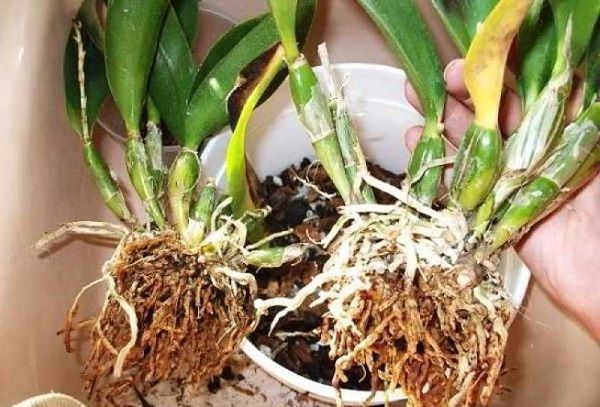
Separation of the cymbidium.
Children
What actions will accelerate the emergence of new shoots:
- moving the plant after a dormant period to a warmer place;
- resumption of spraying on the leaves;
- application of nitrogen-containing fertilizers.
Bulba
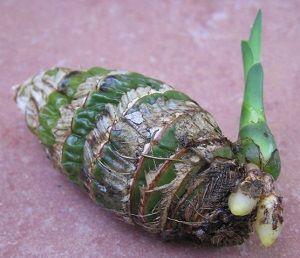 Bulba, which has already faded and has no leaves, can be used as seedlings. Growing an orchid from a bulb includes the following activities:
Bulba, which has already faded and has no leaves, can be used as seedlings. Growing an orchid from a bulb includes the following activities:
- put the remaining bulbs after dividing the bush on wet moss;
- create greenhouse conditions;
- regularly spray the litter and ventilate the bulb;
- after the emergence of sprouts with roots, transplant the bulb into a pot.
Cymbidium, grown from a pseudobulb, blooms in the fourth year.


